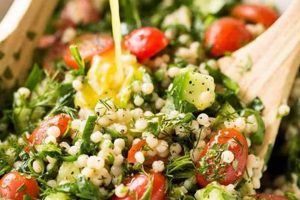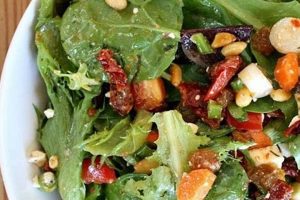A simple Italian salad composed of sliced fresh mozzarella, tomatoes, and basil, seasoned with salt and olive oil, often with a balsamic glaze. Variations may include black pepper, oregano, or pesto. An example would be arranging overlapping slices of ripe tomato and fresh mozzarella on a platter, garnishing with fresh basil leaves, and drizzling with extra virgin olive oil and balsamic glaze.
This dish showcases the fresh, high-quality ingredients central to Italian cuisine. The combination of flavors and textures the creamy mozzarella, the juicy sweetness of tomatoes, and the peppery basil creates a harmonious and refreshing experience. Its simplicity makes it a popular appetizer, side dish, or light lunch. Originating on the island of Capri, it is believed to have been created in the early to mid-20th century, possibly as a tribute to the Italian flag with its red, white, and green colors.
Further exploration will cover variations, ingredient selection, preparation techniques, and serving suggestions to create the perfect embodiment of this classic Italian dish. Optimal tomato and mozzarella choices will be discussed, alongside advice on balsamic glaze selection and the art of artful presentation.
Tips for a Perfect Caprese Salad
Achieving optimal flavor and presentation requires attention to detail. These tips offer guidance on ingredient selection and preparation techniques.
Tip 1: Tomato Selection: Opt for ripe, in-season tomatoes. Heirloom varieties offer diverse flavors and vibrant colors. Roma tomatoes, with their lower water content, are also an excellent choice.
Tip 2: Mozzarella Quality: Fresh mozzarella, preferably mozzarella di bufala campana, offers superior flavor and texture. Avoid pre-shredded or low-moisture varieties.
Tip 3: Basil Freshness: Use fresh basil leaves. Slightly larger leaves allow for tearing, preserving their delicate oils and preventing bruising.
Tip 4: Olive Oil: Extra virgin olive oil, with its robust flavor, is essential. A high-quality oil enhances the salad’s overall taste.
Tip 5: Balsamic Glaze: A thick, aged balsamic glaze adds a touch of sweetness and acidity. A drizzle is sufficient; avoid overwhelming the other flavors.
Tip 6: Seasoning: Sea salt and freshly cracked black pepper enhance the natural flavors of the ingredients. Exercise restraint to maintain balance.
Tip 7: Arrangement: Arrange tomato and mozzarella slices in an overlapping pattern on a platter. Garnish with whole basil leaves for an elegant presentation.
Tip 8: Serving Temperature: Serve the salad slightly chilled, but not cold, to allow the flavors to fully develop. Allowing ingredients to reach room temperature after chilling optimizes flavor release.
Following these guidelines ensures a delightful sensory experience, highlighting the fresh, high-quality ingredients.
By understanding the nuances of ingredient selection, preparation, and presentation, one can elevate this simple salad to a culinary masterpiece.
1. Fresh, High-Quality Ingredients
The essence of a successful Caprese salad lies in the freshness and quality of its components. This dish, with its simple composition, relies heavily on the inherent flavors of each ingredient. Subpar ingredients result in a mediocre salad, while premium components elevate it to a culinary delight. The following facets explore the impact of ingredient quality:
- Tomatoes:
Ripe, flavorful tomatoes are paramount. In-season tomatoes, ideally locally sourced, offer the best flavor and texture. Bland, out-of-season tomatoes detract significantly from the overall experience. Heirloom varieties, with their diverse flavors and vibrant colors, can enhance both taste and visual appeal. Roma tomatoes, due to their lower water content, provide a firmer texture, preventing a watery salad.
- Mozzarella:
Fresh mozzarella, preferably mozzarella di bufala campana, offers superior flavor and texture compared to processed varieties. Its creamy texture and delicate flavor complement the tomatoes and basil. Low-moisture or pre-shredded mozzarella often lacks the desired creaminess and fresh taste, compromising the salad’s integrity. Investing in high-quality mozzarella is crucial for an authentic experience.
- Basil:
Fresh basil leaves provide the aromatic, peppery element crucial to the Caprese salad’s flavor profile. Dried basil lacks the vibrancy and fresh aroma of its fresh counterpart. Larger basil leaves allow for tearing, preserving their delicate oils and preventing bruising, which can occur with chopping. The quality and freshness of basil significantly impact the overall sensory experience.
- Olive Oil:
Extra virgin olive oil, with its robust flavor and fruity notes, is indispensable. A high-quality olive oil elevates the other flavors, contributing to a richer, more nuanced taste. Low-quality or generic oils lack the complexity and depth required to enhance the salad. The olive oil’s quality directly correlates with the overall flavor profile.
The interplay of these high-quality ingredients creates a symphony of flavors and textures. The sweetness of ripe tomatoes, the creamy richness of fresh mozzarella, the peppery bite of basil, and the fruity notes of extra virgin olive oil combine to create a harmonious and refreshing culinary experience. Compromising on ingredient quality diminishes this delicate balance, resulting in a less satisfying outcome. Therefore, prioritizing fresh, high-quality components is essential for a truly exceptional Caprese salad.
2. Proper Ingredient Preparation
Proper ingredient preparation is fundamental to a successful Caprese salad. While the recipe boasts simplicity, attention to detail in preparing each component significantly impacts the final dish. This involves more than simply slicing ingredients; it encompasses techniques that optimize flavor, texture, and presentation. The following facets explore the crucial role of proper ingredient preparation:
- Tomato Preparation:
Slicing tomatoes evenly ensures consistent flavor distribution and contributes to a visually appealing presentation. Thickness influences texture; thicker slices offer a more substantial bite, while thinner slices provide a delicate melt-in-the-mouth experience. Removing the core and seeds, particularly from larger tomatoes, prevents excess moisture in the salad, maintaining optimal texture and preventing the flavors from becoming diluted. Proper slicing technique, such as using a sharp knife and a gentle sawing motion, preserves the tomato’s integrity and prevents bruising.
- Mozzarella Handling:
Allowing fresh mozzarella to drain before slicing prevents excess moisture from seeping into the salad. Patting the mozzarella dry with a paper towel further ensures a firm texture and prevents a watery dish. Slicing the mozzarella into even rounds or slices, similar in size to the tomato slices, creates a balanced presentation and ensures each bite contains a harmonious combination of flavors. The temperature of the mozzarella is also crucial. Serving it slightly chilled enhances its texture and flavor.
- Basil Treatment:
Tearing basil leaves by hand, rather than chopping them with a knife, preserves their delicate oils and prevents bruising. Bruised basil can develop a bitter flavor, detracting from the overall taste. Larger leaves lend themselves well to tearing, while smaller leaves can be left whole. This method maximizes the release of basil’s aromatic oils, enhancing the sensory experience.
- Olive Oil Application:
Drizzling olive oil over the assembled salad, rather than tossing the ingredients in it, ensures even distribution and prevents the delicate ingredients from becoming overly saturated. This allows the flavors of the individual components to shine through while the olive oil provides a unifying element. A light drizzle is sufficient; too much oil can overpower the other flavors and create an oily texture.
These seemingly simple steps, when executed correctly, elevate the Caprese salad from a basic dish to a culinary masterpiece. Proper ingredient preparation optimizes flavor, texture, and presentation, ensuring a harmonious blend of tastes and a visually appealing final product. By understanding the importance of these preparatory steps, one can fully appreciate the nuances of this classic Italian salad and create a truly exceptional dining experience.
3. Authentic Italian Flavors
Authenticity in a Caprese salad hinges on employing ingredients and techniques true to its Italian origins. The dish’s simplicity amplifies the importance of genuine flavors, creating a cohesive and harmonious taste experience. Deviation from these principles can compromise the salad’s integrity, resulting in a dish that lacks the characteristic freshness and vibrancy of a true Caprese.
- Emphasis on Fresh, High-Quality Ingredients
Italian cuisine prioritizes fresh, locally-sourced ingredients. A genuine Caprese salad relies on ripe tomatoes bursting with flavor, fresh mozzarella with a delicate, creamy texture, and fragrant basil leaves. Imported, out-of-season tomatoes or processed mozzarella diminish the authenticity and overall quality. The emphasis on premium ingredients reflects the Italian culinary tradition of celebrating the natural flavors of fresh produce.
- Simplicity in Preparation and Seasoning
Authentic Caprese salads embody the Italian principle of simplicity. Minimal intervention allows the inherent flavors of the core ingredients to shine. Overly complex dressings or additions detract from the pure flavors of tomato, mozzarella, and basil. Simple seasonings, such as sea salt and freshly cracked black pepper, enhance the natural sweetness and subtle peppery notes without masking the essential flavors. This minimalist approach highlights the quality and freshness of the ingredients.
- The Role of Extra Virgin Olive Oil
Extra virgin olive oil is a cornerstone of Italian cuisine. In a Caprese salad, it serves not only as a dressing but also as a flavor enhancer. A high-quality extra virgin olive oil, with its fruity notes and peppery finish, complements the flavors of the other ingredients. The olive oil’s quality is paramount; inferior oils can negatively impact the salad’s overall taste. The selection of an appropriate extra virgin olive oil is essential for achieving authentic Italian flavor.
- Regional Variations and Adaptations
While the core ingredients remain constant, regional variations exist within Italy. Some regions may incorporate oregano or other herbs, while others might add a drizzle of balsamic glaze. These adaptations reflect local traditions and preferences, adding subtle nuances to the classic recipe. Understanding these variations provides insight into the diverse culinary landscape of Italy while showcasing the adaptability of the Caprese salad within authentic Italian cuisine. However, the fundamental principles of freshness, simplicity, and high-quality ingredients remain consistent across these variations.
By adhering to these principles, one can create a Caprese salad that truly captures the essence of Italian flavors. The careful selection of ingredients, the minimalist approach to preparation, and the judicious use of high-quality olive oil contribute to a dish that is both simple and exquisite. This dedication to authenticity ensures a culinary experience that celebrates the fresh, vibrant flavors central to Italian culinary tradition.
4. Balanced Flavor Combinations
Balance defines a successful Caprese salad. The interplay of sweet, acidic, creamy, and peppery notes creates a harmonious flavor profile. Understanding this interplay is crucial for achieving the intended taste experience. This exploration delves into the facets contributing to this balance.
- Sweetness of Tomatoes
Ripe tomatoes provide the foundational sweetness. The variety chosen influences the intensity of this sweetness; heirloom tomatoes offer a nuanced sweetness, while cherry tomatoes contribute a brighter, more concentrated sweetness. This sweetness acts as a counterpoint to the other flavors, preventing the salad from becoming overly acidic or savory. The tomato’s sweetness establishes a base upon which the other flavors build.
- Acidity and Tang
Acidity primarily comes from the tomatoes and, optionally, balsamic glaze. The natural acidity of the tomatoes balances the richness of the mozzarella and provides a refreshing contrast to the sweetness. Balsamic glaze, if used, adds a deeper, more complex acidity. This acidic element is crucial for preventing the salad from becoming overly rich or cloying. The right balance of acidity brightens the other flavors and contributes to the salad’s refreshing character.
- Creaminess of Mozzarella
Fresh mozzarella contributes a rich, creamy texture and a subtle, milky flavor. This creaminess coats the palate, providing a textural counterpoint to the juicy tomatoes and fragrant basil. The quality of the mozzarella significantly impacts this aspect; fresh mozzarella offers a superior creaminess compared to processed varieties. This creaminess acts as a bridge between the other flavors, creating a cohesive and satisfying mouthfeel.
- Peppery Note of Basil
Fresh basil provides a distinct peppery note that complements the other flavors. This peppery element adds complexity and prevents the salad from becoming overly sweet or bland. The freshness of the basil is crucial; dried basil lacks the vibrancy and aromatic intensity of fresh leaves. The basil’s peppery bite provides a refreshing contrast to the richness of the mozzarella and the sweetness of the tomatoes, creating a balanced and dynamic flavor profile.
The Caprese salad’s success relies on the harmonious interplay of these elements. The sweetness of the tomatoes, the acidity of the tomatoes and balsamic glaze, the creaminess of the mozzarella, and the peppery bite of the basil create a symphony of flavors that are both refreshing and satisfying. A well-balanced Caprese salad offers a complex yet harmonious taste experience that exemplifies the beauty of simple, fresh ingredients combined with careful attention to flavor dynamics.
5. Artful Presentation
Visual appeal significantly enhances the dining experience, particularly with dishes emphasizing fresh, vibrant ingredients like the Caprese salad. Artful presentation elevates this simple salad from a basic dish to a culinary statement. Consideration of color, texture, and arrangement transforms the Caprese into a feast for the eyes, amplifying its inherent beauty and stimulating appetite. This visual engagement complements the fresh flavors, creating a more holistic and satisfying sensory experience. For instance, arranging overlapping slices of tomato and mozzarella in a circular pattern on a platter, interspersed with vibrant green basil leaves, creates an aesthetically pleasing contrast and highlights the salad’s inherent tricolor design, reminiscent of the Italian flag. Alternatively, a more rustic presentation might involve tearing the mozzarella and arranging it artfully with the tomatoes and basil, creating a less structured yet equally appealing visual composition.
Practical applications of artful presentation extend beyond home dining. In restaurant settings, presentation directly impacts perceived value and customer satisfaction. A thoughtfully presented Caprese salad signals attention to detail and culinary expertise, enhancing the overall dining experience. This can translate into positive reviews and repeat business. Furthermore, strategic plating techniques, such as using varying heights and textures, can elevate even simple ingredients. For example, slightly elevating the mozzarella on a bed of basil leaves adds visual interest and creates a more dynamic presentation. Such techniques demonstrate culinary skill and contribute to a more refined and memorable dining experience.
In conclusion, artful presentation is integral to the Caprese salad experience. It amplifies the inherent beauty of the ingredients and elevates the perceived value of the dish. While flavor remains paramount, visual appeal significantly contributes to overall enjoyment and satisfaction. From home kitchens to professional culinary settings, understanding the importance of presentation enhances the appreciation of this classic Italian salad. Challenges may arise in maintaining visual appeal while ensuring even distribution of flavors, but thoughtful arrangement can address this. The goal remains to present a dish that is both visually stunning and delicious, showcasing the fresh, vibrant nature of the Caprese salad.
6. Seasonal Variations
Seasonality significantly impacts the flavor profile of a Caprese salad. While the classic recipe remains consistent, utilizing peak-season ingredients elevates the dish, showcasing the nuances of different tomato varieties and basil profiles throughout the year. Adapting to seasonal availability ensures optimal flavor and celebrates the inherent freshness central to this Italian classic.
- Summer Abundance
Summer offers the widest array of ripe tomatoes, from sweet cherry tomatoes to robust heirloom varieties. Abundant sunshine yields intensely flavored tomatoes, enhancing the salad’s sweetness. Basil also thrives in summer’s warmth, offering robust, peppery notes. This peak season allows for experimentation with diverse tomato and basil varieties, maximizing flavor complexity.
- Autumn Transitions
As summer wanes, later-season tomatoes, such as Roma or San Marzano, offer a slightly tangier flavor profile. Basil may become less readily available, necessitating adjustments. Consider substituting late-season herbs like oregano or marjoram, offering subtle shifts in the flavor profile while maintaining the salad’s herbaceous element. These adjustments reflect the season’s evolving flavors.
- Winter Adaptations
Winter presents challenges due to limited tomato availability. Opting for high-quality greenhouse-grown tomatoes or utilizing sun-dried tomatoes offers viable alternatives. Fresh basil may be scarce, making dried basil or pesto a suitable substitute. These adaptations allow for enjoyment of the Caprese concept even during colder months, though the flavor profile will inevitably differ from the summer version.
- Spring Renewal
Spring marks the return of fresh, vibrant produce. Early-season tomatoes, while smaller and less intensely flavored than their summer counterparts, offer a delicate sweetness. Basil begins to reappear, adding its characteristic peppery note. This season signals a return to the classic Caprese profile, albeit with a lighter, more delicate flavor compared to the peak of summer.
By embracing seasonal variations, one can appreciate the Caprese salad’s adaptability while maximizing flavor potential throughout the year. Each season offers unique characteristics, resulting in subtle yet significant shifts in taste. This flexibility demonstrates the enduring appeal of this simple yet elegant Italian classic, adaptable to various culinary contexts and ingredient availability.
Frequently Asked Questions
This section addresses common inquiries regarding the preparation and enjoyment of Caprese salad.
Question 1: Can one substitute other cheeses for mozzarella in a Caprese salad?
While mozzarella is traditional, variations exist. Burrata, with its creamy interior, offers a richer texture. However, substituting cheeses with vastly different flavor profiles compromises the salad’s intended balance.
Question 2: What are the best tomato varieties for this salad?
Ripe, in-season tomatoes are ideal. Heirloom varieties offer diverse flavors and vibrant colors. Roma tomatoes, with their lower water content, also perform well, maintaining the salad’s structural integrity.
Question 3: Should balsamic glaze be used?
Balsamic glaze is optional. While it adds a touch of sweetness and acidity, some prefer the purity of the classic tomato, mozzarella, and basil combination. Use sparingly to avoid overpowering other flavors.
Question 4: Can this salad be prepared in advance?
While best served immediately, advance preparation is possible. Store tomatoes, mozzarella, and basil separately and combine just before serving to maintain optimal texture and prevent the basil from wilting. Dress the salad at the last minute.
Question 5: How should the salad be stored if leftovers remain?
Store leftover salad in an airtight container in the refrigerator. Consume within 24 hours for optimal quality. Note that the texture of the mozzarella may change slightly upon refrigeration.
Question 6: What other herbs can be used besides basil?
While basil is traditional, oregano or marjoram can offer subtle variations, particularly during seasons when fresh basil is less available. However, these substitutions alter the classic flavor profile.
Careful ingredient selection and proper preparation techniques ensure an optimal Caprese salad experience. Adhering to the principles of balance and freshness allows one to appreciate the simplicity and elegance of this classic Italian dish.
The following section will offer serving suggestions and complementary pairings for a complete culinary experience.
Conclusion
Exploration of the salad caprese recipe reveals the importance of fresh, high-quality ingredients. Proper preparation techniques, including slicing tomatoes evenly, handling mozzarella delicately, and tearing basil leaves, optimize flavor and texture. Authenticity relies on extra virgin olive oil, fresh basil, and a balanced flavor profile, encompassing sweetness, acidity, creaminess, and a peppery note. Artful presentation enhances visual appeal, while seasonal adaptations allow for year-round enjoyment with varying flavor nuances. Addressing common inquiries clarifies preparation methods and ingredient selection.
The enduring appeal of the salad caprese recipe lies in its simplicity and reliance on fresh, vibrant ingredients. Understanding the nuances of preparation and ingredient selection allows for a deeper appreciation of this classic Italian dish. Continued exploration of variations and adaptations offers opportunities to elevate the culinary experience further.






